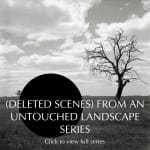James Tylor
(Deleted Scenes) From an Untouched Landscape series, 2013
inkjet print on hahnemuhle paper with hole removed to a black velvet void
50 x 50 cm
edition of 5 + 2 AP
Further images
-
(View a larger image of thumbnail 1
)

-
(View a larger image of thumbnail 2
)

-
(View a larger image of thumbnail 3
)

-
(View a larger image of thumbnail 4
)

-
(View a larger image of thumbnail 5
)

-
(View a larger image of thumbnail 6
)

-
(View a larger image of thumbnail 7
)

-
(View a larger image of thumbnail 8
)

-
(View a larger image of thumbnail 9
)

-
(View a larger image of thumbnail 10
)

-
(View a larger image of thumbnail 11
)

-
(View a larger image of thumbnail 12
)

-
(View a larger image of thumbnail 13
)

-
(View a larger image of thumbnail 14
)

-
(View a larger image of thumbnail 15
)

(Deleted Scenes) From an untouched landscape highlights the contemporary absence of Australian Aboriginal culture within the Australian landscape and how this phenomenon is a direct result of the impact of...
(Deleted Scenes) From an untouched landscape highlights the contemporary absence of Australian Aboriginal culture within the Australian landscape and how this phenomenon is a direct result of the impact of European colonisation.
The first European colonists forced the local Indigenous people off their traditional lands and into small Christian missions and government reserves. This allowed the new arrivals free access to clear the land for settlements, forestry and agriculture etc. This clearing of the landscape resulted in the removal of Indigenous cultural artifacts and our identity from the Australian landscape.
Today the absence of Indigenous culture within the Australian landscape is censored by this process of colonisation and has left much of the Australian landscape with the appearance that it was ‘Untouched’ before European arrival.
The first European colonists forced the local Indigenous people off their traditional lands and into small Christian missions and government reserves. This allowed the new arrivals free access to clear the land for settlements, forestry and agriculture etc. This clearing of the landscape resulted in the removal of Indigenous cultural artifacts and our identity from the Australian landscape.
Today the absence of Indigenous culture within the Australian landscape is censored by this process of colonisation and has left much of the Australian landscape with the appearance that it was ‘Untouched’ before European arrival.














